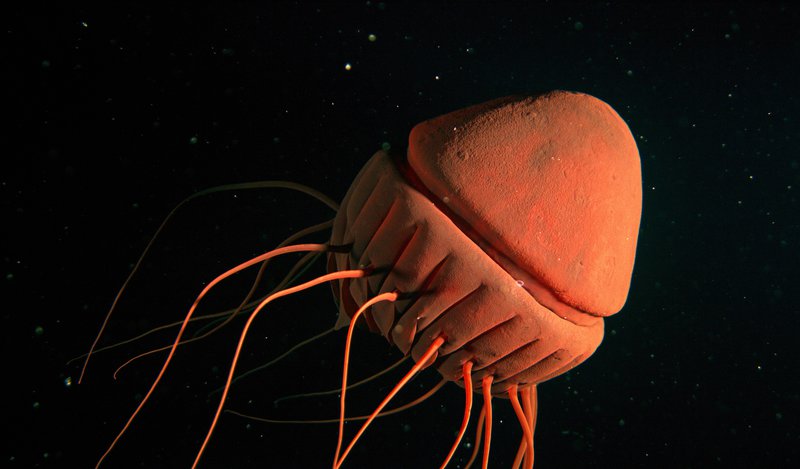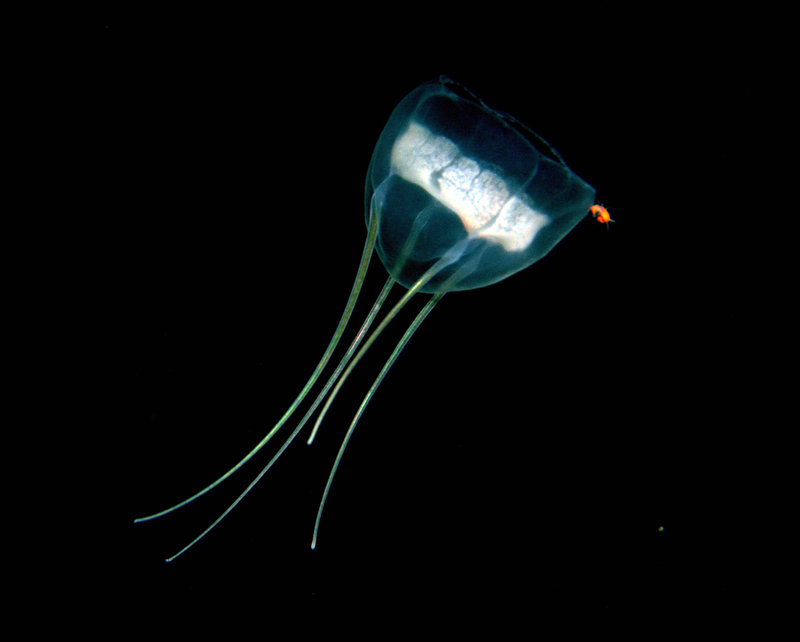
By Dhugal Lindsay JAMSTEC
August 2, 2019
A storm has blown up and for the first time since the cruise has started, I have had more than four hours of sleep in one day. So, feeling refreshed, today I would like to introduce a couple of animals we encountered while diving the remotely operated vehicle (ROV) Global Explorer through the ocean's midwater zone. My name is Dhugal Lindsay and I am an Australian who normally works at the Japan Agency for Marine-Earth Science and Technology (JAMSTEC) in Yokosuka, Japan, but who is now here on the R/V Sikuliaq as part of the International Team that has come together to survey the deeps of the Gulf of Alaska.
The first animal I'd like to introduce is a crown jelly that goes by the Latin name of Periphyllopsis braueri. It was first described in 1902 by Dr. Ernst Vanhöffen, based on the fragments of an animal caught in the Indian Ocean near the Cocos Islands during the "Valdivia" Expedition of 1898-1899. It was named after Vanhöffen's mate, Dr. August Brauer, who took part in the same expedition.
I had seen this species off the northeastern seaboard of Japan back in the spring of 2002, but as this animal gradually loomed larger and larger upon our approach, I heard myself muttering "Struth, mate. What a whopper!" As it floated close to the ROV's manipulator arm it was obvious that it was too big to sample, as its diameter was greater than that of our suction sampler intake tube’s opening. In Japanese, this medusa is known as the "red steamed bun jelly", for obvious reasons.

Periphyllopsis braueri is a particularly large jelly of a distinctive red color. Image courtesy of NOAA/UAF/Oceaneering. Download larger version (jpg, 3.6 MB).
The second jelly I would like to introduce to you is this four-tentacled beastie that goes by the Latin name of Aegina citrea - a reference to its yellow colour, especially of the tentacles.
The reddish-looking hitchhiker clinging to its bell is a crustacean known as a hyperiid amphipod. Many species of hyperiid amphipods follow a parasitic way of life, living a benthic (bottom-dwelling) existence, even as they float in the plankton, due to their use of jellyfish as habitat. One can often find them munching on the gonads or other tissues of their hosts, but eat too much and you find yourself out of a home!
Aegina citrea is a narcomedusa, which is a group of jellies that (mostly) specialize on eating other jellies as prey. For a hyperiid amphipod, this is the ideal place to live because you can munch on the jelly your host is trying to eat without damaging your home/host. If your host is not that good at catching prey, and you are hungry, then you munch on your host.

What has been assumed to be one widely distributed species, Aegina citrea, is more likely to be several closely related species. Image courtesy of NOAA/UAF/Oceaneering. Download larger version (jpg, 720 KB).
For over 50 years, any narcomedusa with four tentacles and two stomach pouches between each tentacle was assumed to be "Aegina citrea", with records popping up all over the globe. However, in 2017, myself and several colleagues published a paper that showed this was not actually the case. In what was considered a single species, there were actually at least six "hidden" or "cryptic" species. We have now erected two new families and three new genera to contain them. Working with damaged animals caught in a net means that many taxonomically important morphological characters can be destroyed or become hard to see!
The Gulf of Alaska is one of the areas with many records for "Aegina citrea," but even with the few ROV dives we have done so far during this cruise, we have found and sampled five four-tentacled species that superficially resemble Aegina citrea. The pristine state of the animals caught by the ROV should allow us to clarify who exactly is here. At least two of these species seem new to science, so keep your ears open for new developments! By the way, the huge tentacle roots that run upwards to the apex of the bell are a dead giveaway for Aegina citrea.